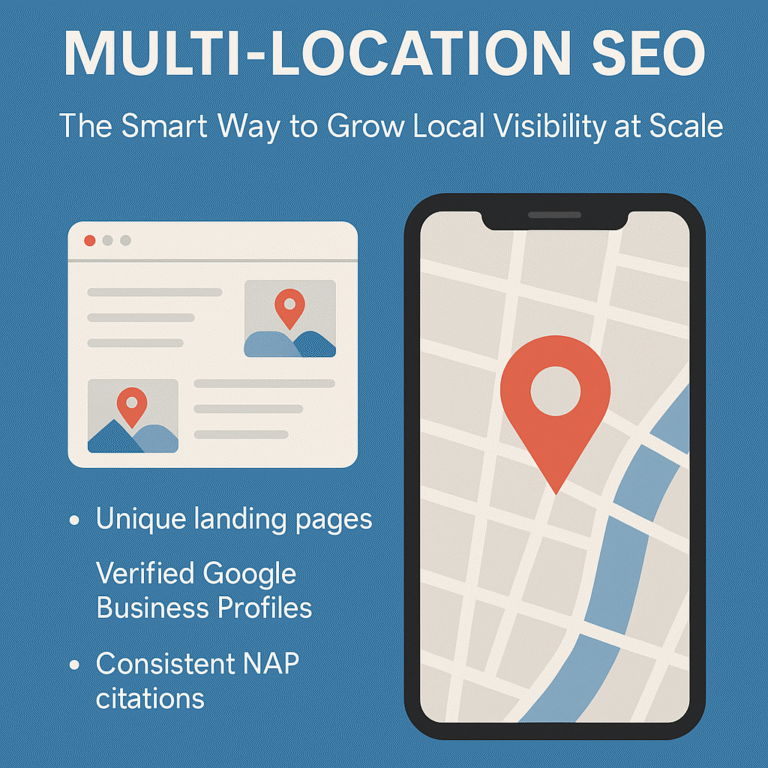Mastering Multi-Location SEO: The Smart Way to Grow Local Visibility at Scale
Blogs | Category
Written By: Lauren Davison
Introduction
Multi-location SEO is the practical playbook for any brand with multiple locations. Customers search for nearby services and expect local accuracy, a correct address, live hours, and real reviews. Without deliberate local optimisation, branches fade from Maps and lose footfall. A smart multi-location SEO strategy treats each site as its own business asset: unique landing pages, verified Google Business Profiles, and consistent NAP citations.
This guide shows why multi-location SEO counts, what to watch out for, and how to grow visibility step by step. Start small, measure fast.
Table of Contents
Why Multi-Location SEO Matters in 2025
Brands with multiple branches, franchises or wide service areas face a familiar problem: every new location multiplies the details you must manage. Opening a store in a city is not just about a lease and staff; it’s about being discoverable where people search. Google’s local ecosystem, the map pack and nearby organic listings reward precision.
Missing or stale data can mean a location never appears to a local customer. Multi-location SEO is the systemised approach to keeping every profile, landing page and citation accurate so each branch has the best chance to be found.

What Is Multi-Location SEO?
Definition and Purpose
At core, multi-location SEO means optimising each business location to rank for local intent in its specific market. Think of a security company or a restaurant chain that wants separate visibility in Manchester, Birmingham and Leeds. Each place must signal relevance for its nearby audience. That requires bespoke copy, local links and tailored on-page signals.
How It Differs from Standard Local SEO
Local SEO for multiple locations differs from single-store work; standard local SEO focuses on a single storefront or service area. Multi-location work multiplies tasks and risks. A franchise SEO strategy multiplies tasks and risks in ways that single-location operators rarely see. You’re not managing one listing or one page; you manage an ecosystem — multiple Google Business Profiles, distinct landing pages, and a deliberate plan to avoid internal competition or cannibalisation.
The Common Challenges of Multi-Location SEO
Duplicate Content and Cannibalisation
One of the fastest ways to stunt local performance is to copy-paste the same service page across dozens of city URLs. Google struggles to choose which page to surface. The solution is straightforward but not easy: write location-tailored content that answers local search intent. Add local landmarks, recent jobs, and region-specific testimonials to establish uniqueness.
Inconsistent Business Data (NAP Issues)
Tiny differences in business name, address or phone format create big downstream problems. A missing suite number or different phone punctuation breaks NAP consistency and weakens trust signals. Use a single source of truth and listing management processes to push uniform NAP to citation sites and directories.
Managing Multiple Google Business Profiles (GBPs)
Every branch needs its own GBP, verified and configured. That means correct categories, up-to-date hours, and fresh photos. It also means monitoring reviews and responding per location. Without a process, profiles slip, hours stay wrong, photos get old, and customers get frustrated.
Proven Strategies to Scale Multi-Location SEO Without Chaos
1. Build Dedicated Local Landing Pages
Create a clear URL structure — for example, /manchester or /locations/manchester, and give each page a real local flavour. Include address, opening hours, an embedded map, nearby landmarks, and locally relevant reviews. These business location pages’ SEO practices help match geo-targeted keywords with content that satisfies local intent.
2. Optimise and Link Google Business Profiles (GBPs)
Verify and claim each GBP. Populate every field, publish local posts or offers, and use UTM tagging on campaign links. This is where Google Business Profile optimisation affects clicks, calls and directions.
3. Maintain NAP Consistency Across the Web
Invest in a single source of truth for NAP data. Audit common aggregator sites and correct discrepancies. Local citations and NAP consistency are non-negotiable for steady local performance.
4. Use Structured Data and Schema Markup
Add structured data markup (LocalBusiness schema) to every location page. Include geocoordinates, opening hours, and sameAs links to major directories. Structured markup helps search engines securely map each page to a physical place and enable richer results.
5. Create Localised Content at Scale
Don’t treat every location as a checkbox. Produce community-specific blogs, local case studies, and press pieces. Talk about a recent installation in a neighbourhood, sponsor a local event, or share a customer story that names the town. Local content marketing builds regional relevance without repeating the same copy.
6. Local Link Building
Attract links from town chambers of commerce, local directories, event organisers, and community blogs. Sponsor a sports team or run a workshop and secure coverage. These local links carry strong, contextual signals that search engines value.
7. Centralised SEO Management Tools
Use dashboards to view rankings, GBP engagement and organic sessions by location. Add store locator optimisation and tracking for service area businesses where maps and boundaries matter. Centralised tools let you compare branches and replicate success across similar areas, scaling local search visibility without losing control.
Advanced Tips for Scaling Smoothly
Automate with CMS and APIs
Choose a CMS that supports templates plus local overrides. Use APIs to update hours, manage offers, or pull live review feeds into each location page. Automation reduces manual errors while preserving the ability to localise.
Analyse search intent by location
Keywords shift by place. “Restaurant in Manchester” and “family restaurant in Leeds” signal different motives. Use keyword tools to map micro-intent and adapt meta tags and headings accordingly. Geo-targeted keywords plus intent-focused copy convert better.
Monitor Reviews and Reputation per Location
Responding to reviews is a local trust signal. Keep templates for quick replies, but always personalise. Use sentiment monitoring to flag emerging problems and act fast.
Begin with three pilot locations and test for 90 days: measure traffic, GBP actions, and conversions. Use lessons from pilots to refine landing pages, review workflows, and citation fixes before rollout across all branches.
Check and adjust based on AI insights
AI search is always changing. What works today can change tomorrow. Update schema, produce new content, and optimise backlinks to keep local SEO strategies in the UK competitive.
Measuring Success Across All Locations
Key Metrics to Track
Local pack rankings, GBP engagement (clicks, calls, directions); organic sessions per location page; and the number of local backlinks and citations. These metrics show whether your location-based SEO optimisation is earning visibility and visits.
Benchmark and Optimise
Set regular audits. Refresh photos, update offers, and republish content when details change. Compare branches to find repeatable patterns. What works in one city can be adapted elsewhere if the variables are understood.
The Future of Multi-Location SEO
AI will automate routine updates and help personalise content at scale. Predictive models will show where demand is rising before competitors notice. Still, fundamentals correct NAP, unique local pages and community links will remain the backbone of scaling local search visibility.
Final Thoughts - Scaling Smart, Staying Local
Sustainable growth in multi-location SEO depends on balancing centralised control with authentic local presence. Keep your business data clean, ensure each page feels unique to its community, and nurture genuine local relationships. When brands invest in structured data, consistent listings, and location-focused content, they build trust while amplifying visibility across every region.
Speak with the team at Midland Marketing for a friendly consultation and insights tailored to your growth goals.
Frequently Asked Questions
- What does multi-location SEO really mean?
It’s about helping each branch of a business show up in its own area. Whether you’ve got two offices or twenty, each one deserves to be visible when people nearby search for what you offer.
- Why should a business care about it?
Because customers don’t look for “your brand,” they look for what’s close. If one branch doesn’t appear in maps or local results, that’s missed traffic — and missed sales.
- Is it different from regular local SEO?
Yes. Local SEO focuses on one spot. Multi-location SEO is like juggling — every location needs its own page, reviews, and listings that stay accurate and fresh.
- What makes it work best?
Keep your details the same everywhere — name, phone, address. Write short, local stories or updates. Add real photos. Link from nearby blogs or community pages. Simple, but powerful.
- How do you know if it’s working?
Watch how each branch performs. Are more people calling, asking for directions, or visiting the local page? If those numbers rise, your strategy’s on the right track.

Written by - Lauren Davison
Introducing Lauren – one of our content writers who has a flair for SEO and creative strategy!
With a Master’s Degree in Creative Writing, Lauren has niched down into SEO and content writing.
Outside of work, she loves watching the darts, reading and the pub on the weekend.
Want some more?
Latest Insights & News

Reciprocal Links in SEO: Do They Still Boost Rankings or Risk Penalties?
For the keyword “reciprocal links SEO,” focus on explaining how reciprocal linking works today. Reciprocal links are not harmful by default, but Google can flag excessive or manipulative link exchanges. To stay safe, only exchange links when they are contextually relevant, natural, and valuable to users.

SEO as the Foundation of Digital Growth: Why It’s More Than Just a Marketing Tactic
When focusing on “SEO for business growth,” highlight how SEO directly contributes to long-term scalability. Modern SEO goes beyond ranking—it boosts brand visibility, qualified traffic, customer trust, and conversion opportunities. To optimize effectively, ensure your content covers user intent, builds topical authority, and leverages technical SEO elements like fast loading, mobile-friendly design, and structured data.

AEO Mastery: Step-by-Step Guide to Building AI Citations & Boosting Visibility
When targeting the keyword “AEO Guide to Building AI Citations & Boosting Visibility,” focus on Authoritative Engine Optimization (AEO) principles. AI-driven search requires clear, structured, and entity-rich content.
